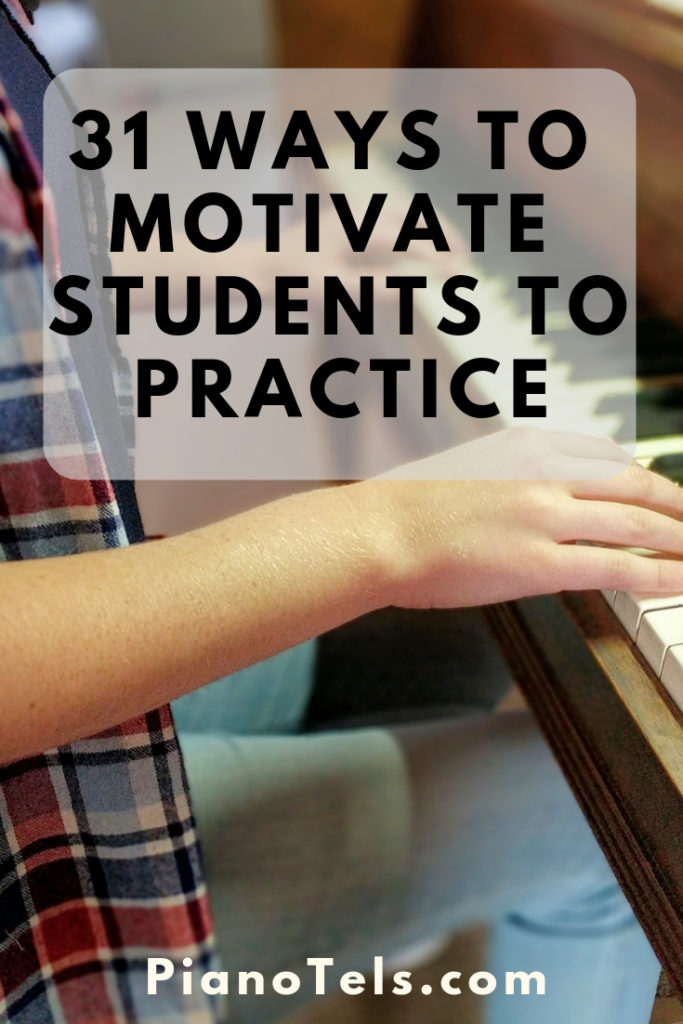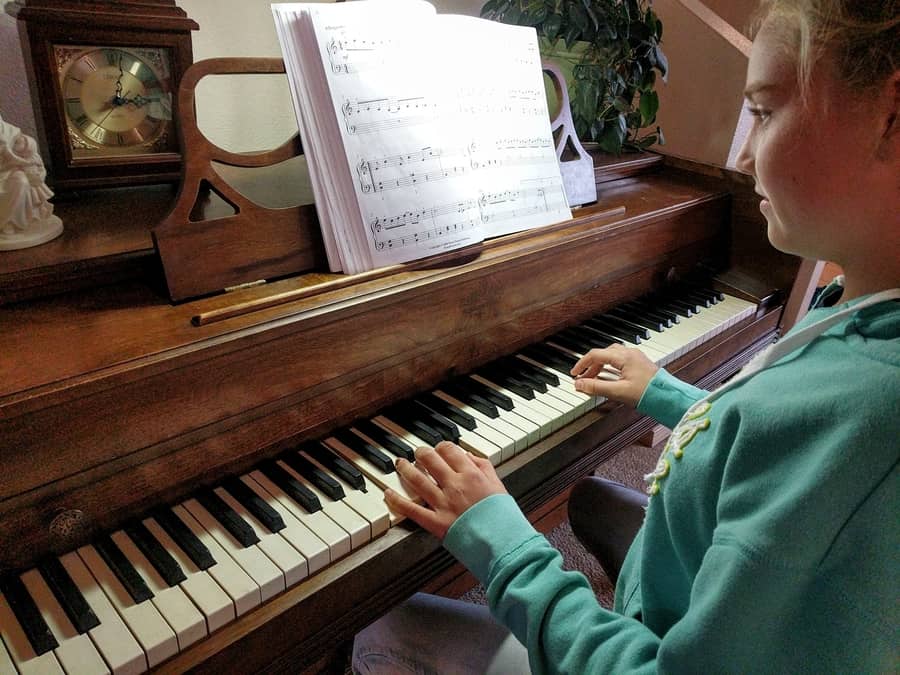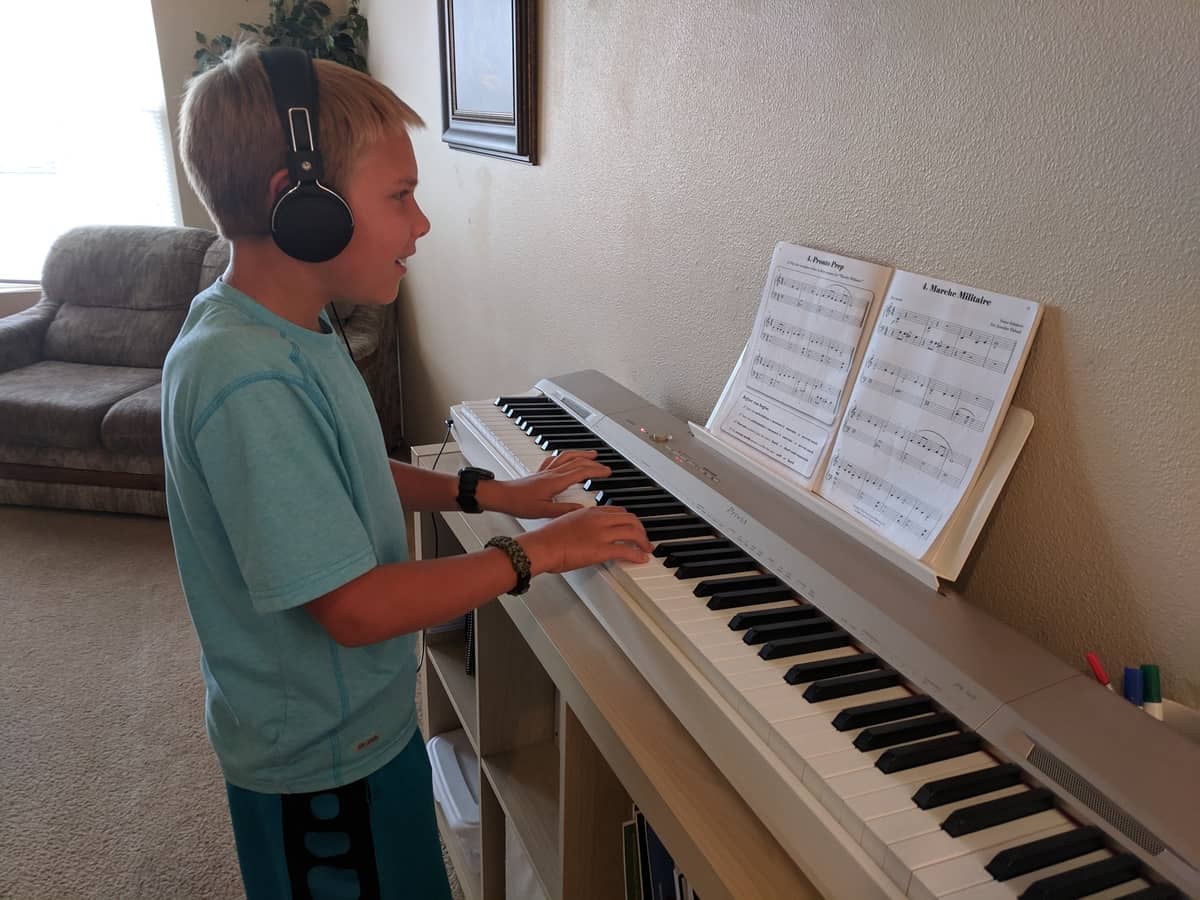
I have been fairly disappointed with just how much “fluff” I have found on the internet when it comes to motivating kids to practice. I want a list of ideas that really work. I read through dozens and dozens of articles, and I have ready about six books on the subject of motivation and these are some of the best things I have found. Many of the articles I read came from college campuses teaching their professors how to motivate their students.
This is a compilation of 31 ways to get students to practice piano and to help increase their motivation.
- Hold a performance. Having a deadline to have a music piece “performance ready” is motivation to practice seriously.
- Change their music. Change up their music and give them something fresh and new to play.
- Allow them to choose their music. Have them bring their own music or at the very least, give them several options of music you would like them to play and let them choose.
- Try a practice competition. Get the students to join in a competition where practicing gives them the opportunity to make the scoreboard. Check out more about this on insidemusicteaching.com by clicking on this link.
- Create a practice schedule. Google “practice schedule” and check out all the images you can find and print off your favorite. Sometimes just having a solid routine is all they need and keeping a practice schedule can help with that.
- Earn piano points. They can earn a piano point for every practice and then exchange them for rewards/incentives at lessons.
- Use the Note Rush App or other technology. If the child needs to learn their notes better and faster, then the Note Rush App certainly is motivating. The kids gets very excited about beating the scores and making sure they are the fastest note reader around.
- Allow the student to choose their own practice schedule. Sometimes just allowing the student to be in control of when and how often they practice will keep them on a routine that is better than what you would have picked.
- Give them practice goals. Break down their practice into small, achievable goals that they can cross off when they are complete.
- Give them long term goals. Keep the end in mind with goals that they can achieve over time. This will also help them to track their progress and gain satisfaction in how far they have come.
- Encourage and praise. Make sure they know you appreciate their hard work. Keep at least 3 positive comments to one negative comment. This provides a great learning environment as the student feels “safe”.
- Get parents help. Get the parents to be the ones holding the student to the fire to make sure they practice. You can remind the parent just how important practice is in making piano lessons worth their investment.
- Printable Piano Phone Practice. TeachPianoToday.com has a creative way of helping the students earn “apps” to add to their phone as they complete each task, including practicing.
- Have them practice in a different way. Choose a technique or challenge that they can do that will get them to practice in a way they haven’t been doing. Have them mix up the song and play it out of order. Have them play it in a new key, play it stacatto, play it fast, or slow. Change it up to make it more interesting and with variety.
- Try “Shhh…Your Piano Teacher Thinks This is Practice”. This is a piano practice handbook that brings new life to piano practice. Unfortunately, it’s not free. But you can give it a go for $40 for unlimited copies.
- Choose songs that are not too easy. You will want them to have material that is challenging enough for them to want to master it. Choose songs that are too easy and they won’t need to practice — they will show up the next lesson and play it so well that it appears as if they did. I did this all the time in my lessons growing up. I never practiced because I never needed to!
- Choose songs that are not too hard. You do have to make sure that they can have songs that they will be able to succeed in. They can become discouraged if it is too difficult and will often just give up or just practice one part over and over again without every learning the rest of the song.
- Enable them to succeed. Give them everything that they need in order to succeed in learning and mastering their song during their practice that week. Make sure they are ready to take it on before they leave the lesson. Work through the most difficult passages with them and give them tips about how to succeed in other areas of the song.
- Be their inspiration. Continually inspire them, encouraging them, and exemplifying what success looks like. Assure them that you are putting them on the path of success and that they are already succeeding.
- Play for them, or watch YouTube videos that inspire them. Every time I watch a well-played song either on YouTube or in person, it makes me want to get to the piano and start playing again! My students particularly enjoy songs from The Piano Guys or David Hicken.
- Educate them on the direct correlation of effort to success. This may seem obvious, but sometimes they need a pep talk on just how important practicing the piano is and how it directly affects their abilities and skills in the piano.
- As the teacher, be in love with music! It is hard not to catch the fire of someone else’s enthusiasm when they absolutely love what they are teaching.
- Teach them the relevance of what they are learning to their lives. If they understand why they are playing the piano, and why this is important to their life, then they may decide its something worth pursuing. Help them catch the vision of what this will do for them in their life.
- Track progress. Record the students every once in a while. Over time, pull out some of the recordings from the past to show them just how far they have come. This is a fun activity as they are often surprised to hear or watch themselves and realize that they are much better now than they used to be. Progress can be hard to measure in piano, so it is motivating to have a way to track that progress that the students can totally see themselves.
- Develop a relationship of trust with the students. When the students trust the teacher, knowing that what is being asked will be truly for their best good, then they are more willing to do it. Build the relationship by knowing your students, taking interest in their well-being and what they feel and need, adjusting your own ideals to theirs, and being a cheerleader while also pushing them to excel.
- Find a peer model for your students to identify with. Give the students an opportunity to connect with other students that they can use as role models. Sometimes it seems unattainable to ever become as talented as the teacher, but they can identify and raise up to the challenge when it is a fellow student.
- Have them self-reflect. Allow them the opportunity to determine their own strengths and weaknesses and determine what they should be working on and how often.
- Use their interests to motivate them. Find out their interests and use that to motivate them to practice. For instance, I have a student who loves video games, so I got him a whole music book inspired by video games. (Check it out here.) Perhaps they are interested in composing music. Encourage them to use some practice time to create a line of their song, or a title, or a chord progression.
- Make it fun. Making piano lessons fun can change the whole perspective of “piano” for the student. If they think that piano is fun, then what’s to stop them from practicing all week? After all, it is called playing the piano for a reason.
- Play the music for them. Hearing the music played well can give them a desire to play it themselves.
- Teach them how to practice. Make sure they know what it means to practice. Make it clear what you expect and make it achievable. Teach them the most effective strategies for achieving their goals in their practice. Check out my article on 21 Fun Ways to Practice Piano.

These 31 ideas can be used to help your student succeed and help them want to practice in order to do so. It is worth taking this list a step further to make sure that we understand what motivation really is and how best to instill it in our students.
Intrinsic vs Extrinsic Motivation
Intrinsic motivation is when the student is self-motivated. The motivation comes from within. They want to succeed because they want to, not because you want them to. Intrinsic motivation is definitely the best kind of motivation because it lasts. It becomes the student’s driving force and outside factors don’t affect that.
Extrinsic motivation, on the other hand, is motivation that has some type of reward. The motivation comes from outside of themselves. It is motivation that definitely increases quickly and has a spike of interest that produced results pretty quickly. We extrinsically motivate our students with bribes and rewards. The problem with extrinsic motivation is that is very short-lived. It doesn’t last for long and you always have to find new, better, and bigger rewards to keep the motivation. So while it does have a measure of success, it isn’t ideal.
The list of 31 ways to motivate students have a list of both intrinsic and extrinsic motivators. I believe a little mix of both can do the trick. Sometimes we have students that just need a little push to get them through their “rut” and back into enjoying playing piano just to enjoy playing. So I offer an extrinsic motivator. A reward of some sort. Once they develop the habit of practicing, then I try and steer away from the extrinsic motivators and help them develop their own motivation.

Let them be in control.
When the student feels autonomous, or that things are based off of what they choose and what they feel is best, they are much more likely to be motivated. As much as we can make learning the piano the student’s choice and in their circle of control, the more likely they are to succeed.
How do we do that as piano teachers? How do we let the student be autonomous in their piano lessons?
Let the student be their own teacher. Encourage them to teach themselves — especially in between lessons. Ask them what they learned in between lessons. Ask them what they found out and how they decided to diagnose the problems they found in their piano music. Even just asking them and having a conversation with them about what they did to enhance their experience in the week will change their perspective from passive to active.
As much as possible, allow them to choose their own music. You can make boundaries for this — that perhaps they need to find a classical piece, but that they get to choose which one.
Help them decide what “practice” looks like to them. What goals do they have and in what ways do they think they can use to get there? Help them in making those goals and make sure that you are helping them to push themselves, but not make it too hard, while completely allowing the student to own that goal.
Relevance: Why should they care?
Students have a hard time having motivation and drive when they don’t understand the why. They need a purpose. Give them a purpose that is related to their lives and help them to find that motivation as they learn why this is important to them.
What does this look like for a piano teacher?
This could look like some discussions on why they want to learn the piano. What is their goal — what are they trying to achieve? What is their piano practicing doing to help them achieve what they want out of it?
Relevance is extremely important to use when teaching theory. Who cares what theory is unless they know how its used in music and why its so important! Every time you teach theory, tell them why it’s important and what it will do for their understanding by learning it. For example, whenever I teach chords, I always use those chords for them to play a song afterwards. Since they now know the chords, they can magically play a song — just like that! Theory is relevant to understanding the music and make sure you always show that.
Create a positive learning environment.
Students learning and growth are limited when they don’t feel safe. Fear of the environment, the teacher, or of failure will all limit them in their capabilities.
As a piano teacher what does that look like?
This means that you can make sure that the student knows that you have got their back. You are their biggest cheerleader and anything you say or do is to only make them the best that they can be. Positive feedback and an environment in which they feel appreciated and respected is essential to their ability to learn.
This also means that you teach them how to succeed and make sure that they know that they are on that path. There isn’t any reason why they shouldn’t succeed if you have taught them well and they are willing to put forth the effort.

Mastering the skill.
Most people have an innate desire to learn and to excel at a skill. In piano, it is your job to harness that desire that your students have in order to help them master the skill.
What does that look like as a piano teacher?
What this means is that you help them track their progress. Help them to see that they are succeeding and that they will continue to do so as they learn and practice.
What this means is that you give them appropriate material to master. Music that is challenging enough to push them, but not too challenging to burn them out. Music that is easy enough for them to learn mostly on their own, but not too easy to have no need to practice.
Conquering something difficult has an incredible feeling. Let your student feel that.
Related Questions:
I didn’t practice for my lesson. What do you do? Your teacher will likely not be fooled by your lack of practicing. Be honest with your teacher about your lack of practicing and let them know what you are going to do differently this next week.
How long should a 7 year old practice piano? Younger students, such as a 7 year old, should be practicing for about 10-15 minutes a day. This should be long enough for the student to practice the material the teacher has assigned. For more info, try this article on How Long Should My Child Be Practicing Every Day.
Tel loves her life as a piano player, a piano teacher, and a mom. Amid piano blogging, piano teaching, and piano playing, she loves a chance to fit in a good exercise class, volunteer at her kids’ school and at her church, and go on long dates with her husband. Full bio at About Tel.


